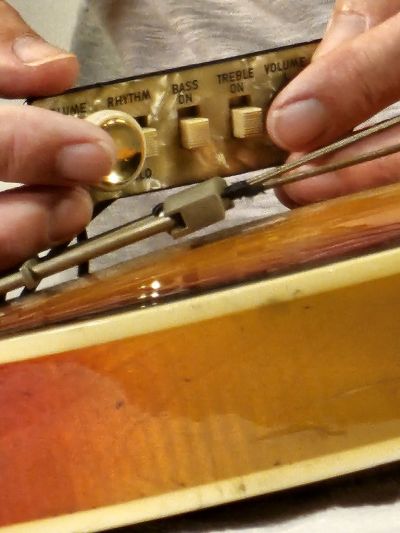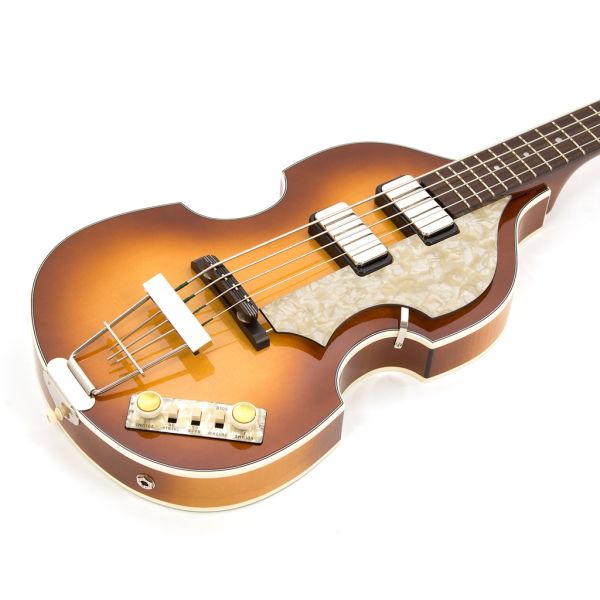Paul McCartney's First Höfner is back!
Höfner expert Nick Wass about finding The Lost Bass
Muzieknieuws 15-02-2024 21:31
After missing for over fifty years, Nick Wass and his team – researchers and journalists Naomi and Scott Jones - found Paul McCartney's first Höfner 500/1 violin bass: one of the most famous instruments in modern music history. We spoke elaborately with Höfner expert Nick Wass. Iand in this exclusive story you'll read all the ins, outs and nerdy facts about the search and THE bass.
Text: Chris Dekker, editor-in-chief of De Bassist magazine, The Netherlands. All pictures used by kind permission of The Lost Bass and copyright of The Lost Bass.
No part of this interview may be used in other articles without permission from the author,
Chris Dekker, chris@debassist.nl
Let's dive into history a bit more. When Stu Sutcliffe left The Beatles in 1961, Paul McCartney took over bass duties. For a while at first on Stu's flipped 500/5 hollow bodied Höfner, but he ordered a 500/1 from the Steinway Music Store in Hamburg. It was sometimes claimed that Paul flipped a right-handed 500/1, but that is completely false. Steinway ordered a left-handed one, and because of its symmetrical shape, it was probably a small effort for the German builders. Connoisseurs assume that this was the first left-handed violin bass ever made. After Hamburg, Paul played the bass on all of the band's early albums and singles.
In 1963, he ordered a second one. The first one - with the pickups close together in what we now call the Cavern spacing - was pretty battered from years of playing and it was probably renovated by Burns. It got a new paintjob, new control knobs and a – probably – wooden housing for the pickups. Meanwhile, Paul played on his second Höfner - with the pickups placed further apart - and this ‘63 is the bass he still does every gig with. Besides the official name 500/1, this bass is known as the violin bass – hence the shape – and of course as Beatle bass. Picture: A young Macca by Eric Koch
Picture: A young Macca by Eric Koch
THE LOST BASS IS BACK
In 1969, right after the Get Back sessions, Paul McCartney's first Höfner bass was stolen from the Apple Building. At least that was what we always thought. After more than fifty years, the bass has been recovered, and in many ways the bass isn’t what the experts thought to be. One of the most important and therefore most precious instruments in pop history is back and it unveiled all it’s sectrets. We spoke exclusively with Höfner historian and former Höfner employee Nick Wass about the search for and finding of the bass. And how does he know it really is the bass? We take you through the search for The Lost Bass.
Picture: Nick Wass inspecting The Lost Bass.
‘What I’m not going to do is give you names and addresses,’ starts Nick, if we talk with him per Zoom. ‘We promised all people who were involved, it would be confidential, but I’m going to tell you the story about how the bass is found. I just talk about people and places. We’re not going to tell anybody the names of the people who were being involved. That will be a secret forever.’
Before we talk about the search we want to know who Nick Wass is, and if he was the right person to authenticate the stolen bass.
‘I started buying vintage Höfners 25 years ago. The first one was a 1964 Verithin, and I got hooked on Höfner. Some years later I got offered a job as marketing manager at the company, because they hadn’t got one. In 2011 we moved from England to Germany and my wife Cathy ended up doing all the social media for the brand, which she still does. I started as the marketing manager and a bit later I became the electric guitar manager too. I am partly retired now.’
So you had access to all the archives?
‘Sure, as marketing manager it became my job to sort the archives out and have it all digitalized. I put it online, it still is online, and I think that’s the right thing to do. Almost the whole archive is online, except for some papers, which shouldn’t be, haha! I developed a big love for the violin bass, Höfner’s most important instrument. I wanted to know more about it, about its designer, how it was built. When I started as the electric guitar manager I wanted to bring new models, but also basses which reflected the tradition. The Green Line Bass, an environmental friendly instrument, was one of the new models. The relic versions were almost made by accident. We make violins, violins often have a relic finish, because players want that, and when I was looking at those, they looked very cool. I wanted to see how it would look on a violin bass, and the series became a success. We also made some anniversary models and so on.’

Picture: The bass (almost) as it would've looked like when Macca bought it in '61. Pic by Höfner.
And I think you made the existing models more historical accurate?
‘As far as possible yes. Almost exactly like in the early 1960s. The production numbers of Höfner basses are quite small. To get certain parts you go to manufacturers and they’ll say: “We can produce them, but with a minimal amount of 25,000.” But we need 200! So some parts aren’t completely accurate, but very, very close. Sorry! We do our best.’
And you co-wrote Hofner - The Complete Violin Bass Story, which must have been a learning experience too?
‘I did, I did it with Steve Russell, also know as Mr. Höfner. He has a huge amount of knowledge, and he created a database, so owners could register their Höfner, which year it was, and all the specs. With this information we could exactly work out what Höfner was building and when. Before that, it was looking at one guitar or guessing. Now we saw the changes from year to year. We wanted to make a book with the complete violin bass history and it is quite accurate. They sometimes ask us to make a second edition, but we’re too old and lazy.’
Well, the subject of today’s story will make an important addition.
‘Yes, sure!’
CUSTOM COPIES OF THE LOST BASS
What can you tell us about your relationship with Paul McCartney and the start of the search?
‘Before the search I was in contact with Paul and his people. Occasionally they wanted spare parts. Not to fit on the bass, but to be ready when anything happened. They also asked me to make another really good violin bass as back up to his ’63, which I did. I talked to Paul and his technical manager Keith Smith about what we should make, and after that Paul said: “Where’s my lost bass? You are from Höfner and you should know where it is!” Of course I didn’t, but that’s where the idea started to search for the bass. Talking about Paul: Everybody is always excited and they ask me if I’ve met with him, but it was always a business relationship. I was sorting out his bass, so it was a working relationship and not fan based.’
Around that time you also made a copy of The Lost Bass; the stolen ’61.
‘I talked to Keith and I thought we’d never get the bass back, after fifty years. But what about making a copy of the bass? Keith thought Paul would love that, so me made two copies for him. One as the bass when he bought it in 1961 and a second as how we thought it looked when it got stolen. You see that bass in some recent videos and pics, and lot of people think it’s the real one.’
Now the bass is found, I’m curious how accurate your copy was. I will ask that at the end of this interview.
‘It was near but not right. The Lost Bass has some things about it we didn’t know. Everybody was wrong about this, it’s quite interesting, but yes: let’s keep that for later!’
Some while ago you started the website thelostbass.com to get attention for the first left handed 500/1.
‘I started it around 2018 and we got some response. People wrote they saw something here or there. For this to work, you need big media coverage, on all sites, in newspapers, and on TV. I was marketing manager of a small company, so nobody seemed interested. Only some German papers wrote about it, but that wasn’t where I wanted it. Initially I got a lead in the US. A guy had a left-handed Höfner and he showed it to some people, claiming it was McCartney’s bass. I talked to some people who saw it, and they thought it could be his. Later I discovered the production dates weren’t right. It was no waste of time, but the coverage just was not wide enough. Not enough people were hearing about it.’
‘Around May of 2023, a couple from England contacted me. Scott and Naomi Jones, who are very respected top level journalists and researchers. Scott is an excellent and well known journalist, and Naomi is a top class researcher, who worked for Channel 4 and the BBC. When they came to the party, Scott was able to get the search into the media, and it exploded with worldwide coverage. I even heard you were on Dutch Radio 1 and 2, talking about it, Chris, and Bart of The Analogues in another program. That got things going. I learned I had no idea how research worked and Naomi was able to look for information in places I didn’t know they existed., She got some information very quickly, which changed everything. All thanks to her skills with research and his skills with media.’
HOW IT GOT STOLEN
I think the first breakthrough was posted at the website in fall 2023: the bass wasn’t stolen in 1969.
‘Everybody, including me, thought it was stolen right after the Get Back sessions. You can see it in the Get Back film, and afterwards it was put away, nobody had ever seen it again, so we all thought it was stolen then. We found out that wasn’t true at all. When it got into the media we got an e-mail through the website which said: “I was the roadie for Wings and I know how it got stolen.” We got in contact and this guy did know where, how and when it was stolen. It was stolen three years later on October 10th 1972. Ian Horne and Trevor Jones – I’m allowed to say their names - worked for Paul as sound engineers. Trevor has died, but Ian told us the story. They had a 3 ton truck they were using to move equipment for Paul to one place or studio to another. The van was loaded, it became late at night, around 22pm, and they decided not to unload it, but to park it nearby Trevor’s house, where they stayed. They couldn’t find a spot to park, so it was parked somewhere nearby in Nothing Hill. They padlocked the van, went back the following morning and they found out someone had broken into it. Two Vox AC-30 amps and the bass were gone. They knocked on all doors to ask for information, but nobody said anything. They reported it to the police and of course they had to tell Paul his bass was gone, being afraid they would lose their jobs. Paul was okay with it: “Don’t worry, stuff happens, I got other basses.” Ian worked another six years for Paul, so it was! Thanks to Ian we knew the date, the situation and it moved the search forward.’
‘For the next step we go back six months. In February 2023, before the search got big, I got an e-mail in which someone described what had happened to the bass. A van was parked on a certain road, in front of a certain house. The goods were stolen, brought into the house, and later were sold in a pub. When I got the information from Ian, I remembered that e-mail and I thought: wow, that is exactly the same story, but told by another person! It all tied together, so I got back to that person. “Sorry I didn’t pay much attention six months ago, but we have new information, so tell us more.” Here the story goes interesting. The guy who wrote us, told us he was an ambulance driver. He and a paramedic had a patient in their ambulance once, who told them the story. I asked for more information, and this time it was the paramedic who told us more. I realized soon enough he told me too much. He told us about hearing something in the back of an ambulance, but he knew too many details. Nobody would remember that from a conversation. At that time I knew the name of the paramedic and, we had the address of the house the bass was taken to.'
AN OLD BASS IN THE LOFT
'And now Naomi came in. She found out who was living in all eight apartments in that house in 1972. We found all the names and one of the names was the paramedic’s! He lived in that house as a kid. I went back to him, I told him we knew he lived in the house and I asked him to tell the truth, promising it would be all confidential, and no police would be involved. He didn’t know who broke into the van – we think we know – but he told us his father wasn’t a great guy, and he was known for stealing. The father had taken the bass to his local pub and he asked the landlord to hide it. A bit later he needed money and sold the bass to the landlord. This was the first move of the bass. The landlord gave the bass to his son, who already played guitar. The son used it a bit, but he and a friend got killed in a car rally accident at university. Very sad. We don’t know exactly what happened next, but his younger brother got the bass, so it ended up with the second son of the landlord. He kept the bass for many years in an attic. This second son died during Covid – also very sad – but his wife is still alive and she saw me on the 6 o’clock news in the UK, asking to please bring the bass back. She knew there was an old a bass in the loft, took it out, saw it could be the bass, and she took some pictures. She went to McCartney’s house, showed the pictures and McCartney’s people picked up the bass!’
‘We talked to people who told us they met a Japanese banker who got the bass, some other person told us a wealthy art collector in Jamaica had it, so we expected an exciting story with millionaire collectors in exotic places. We also thought it would take years, but three weeks after the first real media attention, it was back. The Lost Bass was back!. It stayed with one family for fifty years, first in London and later in a seaside town in the south of England. “Oh, I Do Like to Be Beside the Seaside” is a very English song, and so is this story! As said I can’t give names, but we knew the name of the landlord of the pub, and the lady who handed in the bass had the same name. It’s an unusual name, so nothing like Smith or Jones.’
All the pieces fit together, it must be the bass, but still: it could be a replica?
‘When Paul got it back, he phoned me, which is quite unusual. He was excited as a school boy: “I got the bass!” They asked me to come over to England to make sure it was the bass and authenticate it. Cathy and I drove to England towards the end of September 2023 to check the bass out and that’s all recorded on video. I’d taken some notes and photographs with me, so I could look at certain things, which I knew would authenticate it. There were no doubts. Certain characteristics are very, very hard to replicate. There’s no doubt about it.’
Was it the wood grain you could check? That’s almost a fingerprint of the wood.
‘That was very hard do determine, because Paul had it refinished in 1964. And sorry Paul: they did an awful job. I think Burns Guitars painted it and the polyurethane finish is so thick you can swim in it! They didn’t spray it, but I think they threw buckets of paint on it, ha ha! There are no pics showing the back of the bass, because he’s always wearing it. In 1963, before the refinish, the tuners were replaced, and they put a set of very odd tuners on it. Someone bought six in a row, like on a Fender Stratocaster, but a Beatle Bass has two tuners on each side, mirroring each other. Now two of the tuners are reversed. I know I had to look for that. Later, around 1968, one of these tuners was replaced again by one with a metal button. It’s completely different, it’s on the D string, and in the Get Back documentary you can see it. So three odd tuners and a metal one, were my first clues. You can also see by how it’s painted, from black to red, that it’s the bass.’
Then there is the infamous block around the pickups.
‘When they did the refinish, for some reasons nobody will know, they put the pickups in a big block, instead of using pickup rings. The block was specially made for the bass. It now has a crack near the treble pickup, which can be repaired. It must have been done in a hurry, because it is poorly done. It doesn’t fit, and I f you look from the side, you can look underneath it. You can’t see that when you see the bass from the front.’
I guess back in the day it was hard to get those pickup rings. Nowadays you can order them online.
‘No, it would’ve been much easier, because Selmer was the distributor and they carried a big stock of parts. Selmer was close by at Charing Cross Road, they could’ve ask for rings, they had them on the shelf, but instead they made a big horrible black thing. Burns didn’t do the bass any favours, the spray job is awful and the renovation is not the greatest thing. A shame really. They could’ve just fix it up with the right parts, but it would be harder to be identified and it would be easier to fake it. The tuners are so odd, nobody could fake that. I tried to search for those tuners, but I can’t find anything close. They look like tuners from an acoustic guitar from the sixties. And the wooden block for the pickups? It has 3mm of black lacquer poured on it. It could be wood. It could be plastic. I didn’t want to take anything off the bass in this stage, but we’ll find out in time.’
A PROTOTYPE?
‘There are a couple of colour pictures of the bass. There’s one of Paul wearing a red jumper and playing the bass. If you look at the treble pickup, you see it’s almost gold. While polishing they rubbed off all the nickel covering off and you see the brass casing. On the bass we found out it was the same. It was rubbed though to the brass. Another sign, and there were more little things like that.’
So the reissue you made was better?
No, it was wrong, because we discovered something no one knew. And if they say they knew, they lie. When we turned it around, we discovered Paul’s bass has a domed, rounded back, not a flat one, while all the ‘61 reissues including the copies we made - and some other people made - have flat backs. We were very surprised. In 1961 the basses had solid spruce tops and flat backs, so it was not what we expected. Later, at the end of the year, the tops became laminated plywood, so maybe this is an experimental bass? A prototype? It was a transitional year, so I can imagine Paul going into the Steinway shop, they phone Höfner and ask for a left handed bass, Höfner agrees and maybe they thought: “What can we use? Maybe this prototype? Oh well, it’s only for a kid in Hamburg.” We’ll never know, but it would be typical Höfner. In the end it’s very interesting to know all the replicas are wrong, even the ones we made, ha ha!’
What can you tell us about the state the bass is in?
“Not bad, better than I expected. The lacquer is too thick and it has big cracks, because it was left in a loft: cold in winter and hot in summer. But that doesn’t matter. The pickups don’t work, so the coils must be replaced, which isn’t a problem either. And the neck is broken. The piece that goes into the neck cavity and which hangs over the body is a separate piece of wood. It’s called a scarf joint. The neck is not coming out of the body, but that joint is broken. A long time ago they tried to string the bass right handed with very heavy strings, and after fifty years under that heavy pressure, the neck gave up. And in the process they butchered the nut. We can repair the neck, it’s not a problem.’
A PIECE OF THE PUZZLE
‘We did another discovery. When the bass was refinished, they changed the control knobs. They looked like old sixties radio knobs. On pictures from some years later, in ‘65/’66, it suddenly has the Höfner teacup knobs on it again. How did that happened? When I checked the bass, I discovered it had a control panel from 1964. They stamp a number on the potentiometers and you can date them. The Lost Bass has pots from the end of ’64. Because electronic knowledge moved from ’61 to ’64 it has smaller condensers for the bass boost. I think the original control panel failed and they bought a new one at Selmer’s. As now, they come complete with knobs and jack sockets, so it’s easy to get the old one out and a new one in. So around ’65 it got a new panel and it explains why it got back to proper teacup knobs.’
I guess Paul won’t remember such changes.
‘They were just playing and recording, other people took care of the instruments. If something went wrong, people like Mal Evans would fix it. But it was interesting to find out it was replaced and again it was a piece of the puzzle which pulls it together.’
I’m very glad it is how it was found. No real butchering, no refin in black or purple.
‘I opened the case and I said: “Hey, I’ve been looking for you!” It was exactly as when it was stolen. Thank goodness.’
Will the bass be repaired?
‘I talked with Keith about it. Keith thought it wasn’t that bad. He thought cleaning the frets and putting on some new strings would do it. I advised him not to put strings on it. It will pull the neck off. I think the bass can easily be repaired., I’ve seen guitars and basses in much worse condition. Paul wants it to be fixed up, so he can play it. He doesn’t it to be restored as it came out of the factory in 1961, but as it is now. The pickups need to be repaired, it needs some new tuners, because some ferrules are missing. I would advise a set of ’61 tuners. The neck needs to be repaired and it can use a good cleaning. The nickel has to be polished, I’m glad Paul doesn’t want to change anything.’
Will you and Höfner take care of it?
“Possibly. It will get repaired somehow.’
Or they can ask Burns again?
‘Yes, and put more lacquer on it, haha!
Note of the author: The bass was returned in September 2023, and this interview took place some weeks later. Various matters had to be properly resolved with the carers of the Lost Bass before the find could be announced.
No part of this interview may be used in other articles without permission from the author,
Chris Dekker, chris@debassist.nl








